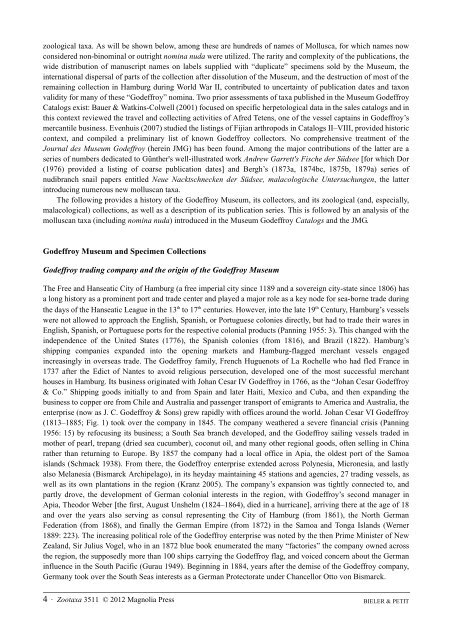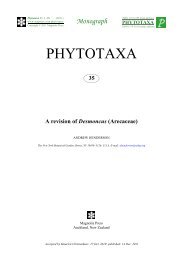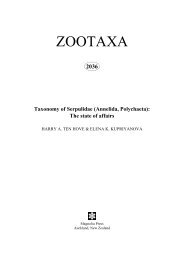You also want an ePaper? Increase the reach of your titles
YUMPU automatically turns print PDFs into web optimized ePapers that Google loves.
zoological taxa. As will be shown below, among these are hundreds of names of Mollusca, for which names now<br />
considered non-binominal or outright nomina nuda were utilized. The rarity and complexity of the publications, the<br />
wide distribution of manuscript names on labels supplied with “duplicate” specimens sold by the Museum, the<br />
international dispersal of parts of the collection after dissolution of the Museum, and the destruction of most of the<br />
remaining collection in Hamburg during World War II, contributed to uncertainty of publication dates and taxon<br />
validity for many of these “Godeffroy” nomina. Two prior assessments of taxa published in the Museum Godeffroy<br />
Catalogs exist: Bauer & Watkins-Colwell (2001) focused on specific herpetological data in the sales catalogs and in<br />
this context reviewed the travel and collecting activities of Afred Tetens, one of the vessel captains in Godeffroy’s<br />
mercantile business. Evenhuis (2007) studied the listings of Fijian arthropods in Catalogs II–VIII, provided historic<br />
context, and compiled a preliminary list of known Godeffroy collectors. No comprehensive treatment of the<br />
Journal des Museum Godeffroy (herein JMG) has been found. Among the major contributions of the latter are a<br />
series of numbers dedicated to Günther's well-illustrated work Andrew Garrett's Fische der Südsee [for which Dor<br />
(1976) provided a listing of coarse publication dates] and Bergh’s (1873a, 1874bc, 1875b, 1879a) series of<br />
nudibranch snail papers entitled Neue Nacktschnecken der Südsee, malacologische Untersuchungen, the latter<br />
introducing numerous new molluscan taxa.<br />
The following provides a history of the Godeffroy Museum, its collectors, and its zoological (and, especially,<br />
malacological) collections, as well as a description of its publication series. This is followed by an analysis of the<br />
molluscan taxa (including nomina nuda) introduced in the Museum Godeffroy Catalogs and the JMG.<br />
Godeffroy Museum and Specimen Collections<br />
Godeffroy trading company and the origin of the Godeffroy Museum<br />
The Free and Hanseatic City of Hamburg (a free imperial city since 1189 and a sovereign city-state since 1806) has<br />
a long history as a prominent port and trade center and played a major role as a key node for sea-borne trade during<br />
the days of the Hanseatic League in the 13 th to 17 th centuries. However, into the late 19 th Century, Hamburg’s vessels<br />
were not allowed to approach the English, Spanish, or Portuguese colonies directly, but had to trade their wares in<br />
English, Spanish, or Portuguese ports for the respective colonial products (Panning 1955: 3). This changed with the<br />
independence of the United States (1776), the Spanish colonies (from 1816), and Brazil (1822). Hamburg’s<br />
shipping companies expanded into the opening markets and Hamburg-flagged merchant vessels engaged<br />
increasingly in overseas trade. The Godeffroy family, French Huguenots of La Rochelle who had fled France in<br />
1737 after the Edict of Nantes to avoid religious persecution, developed one of the most successful merchant<br />
houses in Hamburg. Its business originated with Johan Cesar IV Godeffroy in 1766, as the “Johan Cesar Godeffroy<br />
& Co.” Shipping goods initially to and from Spain and later Haiti, Mexico and Cuba, and then expanding the<br />
business to copper ore from Chile and Australia and passenger transport of emigrants to America and Australia, the<br />
enterprise (now as J. C. Godeffroy & Sons) grew rapidly with offices around the world. Johan Cesar VI Godeffroy<br />
(1813–1885; Fig. 1) took over the company in 1845. The company weathered a severe financial crisis (Panning<br />
1956: 15) by refocusing its business; a South Sea branch developed, and the Godeffroy sailing vessels traded in<br />
mother of pearl, trepang (dried sea cucumber), coconut oil, and many other regional goods, often selling in China<br />
rather than returning to Europe. By 1857 the company had a local office in Apia, the oldest port of the Samoa<br />
islands (Schmack 1938). From there, the Godeffroy enterprise extended across Polynesia, Micronesia, and lastly<br />
also Melanesia (Bismarck Archipelago), in its heyday maintaining 45 stations and agencies, 27 trading vessels, as<br />
well as its own plantations in the region (Kranz 2005). The company’s expansion was tightly connected to, and<br />
partly drove, the development of German colonial interests in the region, with Godeffroy’s second manager in<br />
Apia, Theodor Weber [the first, August Unshelm (1824–1864), died in a hurricane], arriving there at the age of 18<br />
and over the years also serving as consul representing the City of Hamburg (from 1861), the North German<br />
Federation (from 1868), and finally the German Empire (from 1872) in the Samoa and Tonga Islands (Werner<br />
1889: 223). The increasing political role of the Godeffroy enterprise was noted by the then Prime Minister of New<br />
Zealand, Sir Julius Vogel, who in an 1872 blue book enumerated the many “factories” the company owned across<br />
the region, the supposedly more than 100 ships carrying the Godeffroy flag, and voiced concern about the German<br />
influence in the South Pacific (Gurau 1949). Beginning in 1884, years after the demise of the Godeffroy company,<br />
Germany took over the South Seas interests as a German Protectorate under Chancellor Otto von Bismarck.<br />
4 · Zootaxa 3511 © 2012 <strong>Magnolia</strong> <strong>Press</strong><br />
BIELER & PETIT
















